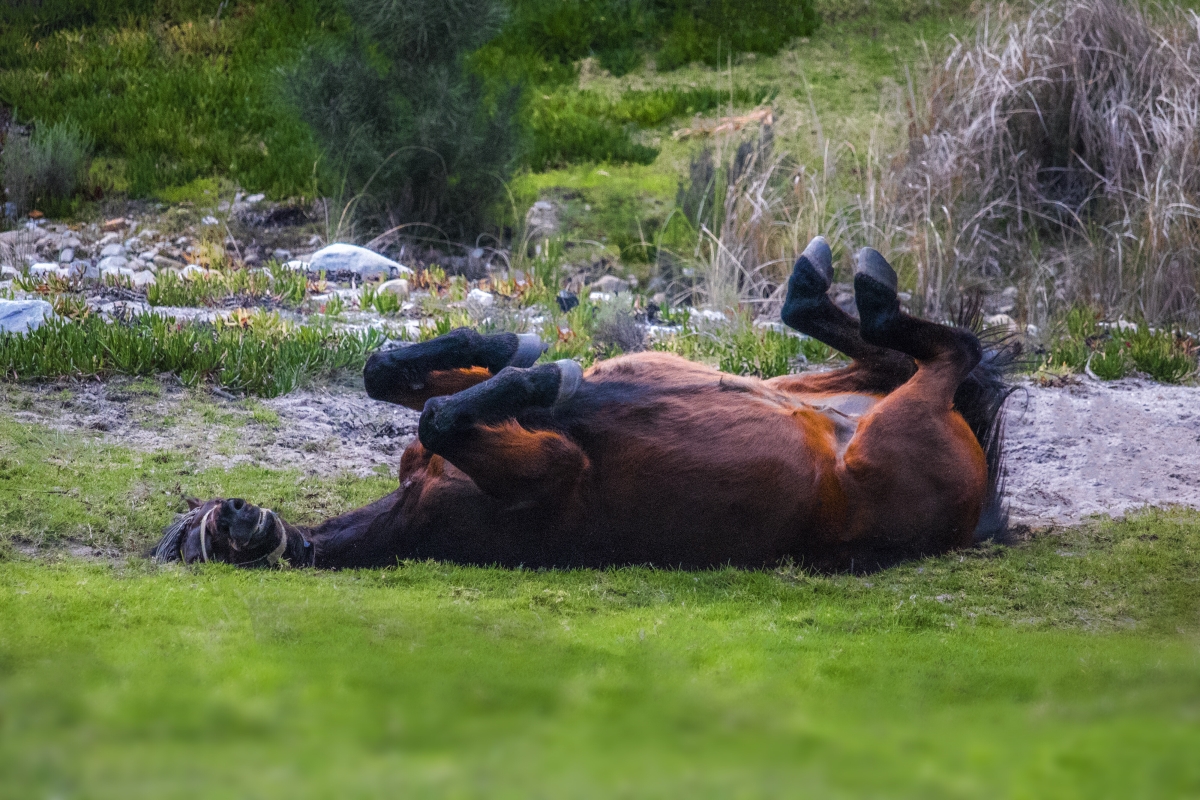Colic is used as a general term and means pain in the stomach. The horse can get stomach pain for many different reasons, ranging from harmless to life-threatening. Never ignore signs that your horse has colic! All horses are different as individuals and show pain differently and in slightly different ways. You as a horse owner must learn to interpret your horse’s signals. With this article, I as a veterinarian want to help you horse owners to understand how to discover, manage, treat, and prevent equine colic.
- What is Colic?
- Clinical Signs of Colic
- A Decreased General Attitude
- A Decreased Appetite or Complete Anorexia
- Looking Back at the Abdomen or Flanks
- Pawing the Ground
- Is Stressed and Shows Pain
- Flehmen (Curling up the Upper Lip)
- Sweating
- High Pulse and Respiratory Rate
- Mucous Membranes Are Either Very Pale or Very Red
- Increased Capillary Refill Time (CRT)
- Kicking
- Lying Down and Rolling
- Looks Like It is Trying to Urinate
- Have Little or No Feces Alternatively Diarrhea
- Moaning and Grinding Teeth
- Increased Abdominal Circumference (Bloating)
- Silent or No Bowel Sounds
- What Should I Do When I Suspect That My Horse Has Colic?
- What Does the Vet Do With a Colic Horse?
- Different Causes of Colic
- Different Treatment Options for Horse Colic
- What Can I Do To Prevent my Horse From Getting Colic?
- Conclusion & Disclamer
- Sources
What is Colic?
The word colic means “abdominal pain” but has become a collective name for all pain from the gastrointestinal tract in horses. Colic is thus not a disease but a series of ailments that lead to pain in the horse’s abdomen. Yet, pain conditions in other organs can cause similar symptoms. And not all pain from the abdomen is from the gastrointestinal tract but can be pain from the kidneys, urinary tract, or genital organs.
Important things to remember about colic cases:
- Time is of the essence – don’t wait too long and hope it will go away. Colic attacks are one of the best reasons to call the vet immediately!
- Colic pains can make the nicest horse dangerous so be careful when the horse is kicking, punching, or rolling!
Clinical Signs of Colic
The pain from the abdomen can vary greatly. As a horse owner, it is important that you are observant and take note of your horse’s particular symptoms during a colic episode.
It is not always easy to determine how sick the horse is when it has colic. The pain can vary greatly in intensity and is not always related to the cause or severity of the colic. Mild pain may only show up as mild agitation and/or reduced general condition and attitude. Severe pain may produce dramatic symptoms such as rolling uncontrollably. Symptoms may come and go intermittently. The following are common symptoms of colic:
A Decreased General Attitude

The horse becomes depressed and is not its usual self. It may hang by itself in the pasture or turn inwards in the stall. Doesn’t stand with ears pointed towards you when you enter the stable.
A Decreased Appetite or Complete Anorexia
Typically, the horse has not eaten its feed as usual. Has the horse left concentrates, hay, or both? When you offer it food, it just chews listlessly or won’t even take the food into its mouth.
Looking Back at the Abdomen or Flanks

This is a common symptom of colic. Horses may not be able to talk but they can show where they are in pain. The horse looks towards the abdomen, which can happen when standing and lying down.
Pawing the Ground

Horses with colic may stand and paw frequently, sometimes followed by the horse lying down and rolling. Sometimes traces of pawing can be seen in the horse’s stall and bedding when it has made a big mess.
Is Stressed and Shows Pain
When the horse is in pain, it may show typical symptoms of stress such as restlessness, wandering, sweating, and elevated heart rate. You should also pay attention to whether the horse exhibits a so-called “pain face”. Researchers have shown that when in pain, the horse shows small changes in facial expression. You can learn more about Equine Pain Face by watching the video below.
Flehmen (Curling up the Upper Lip)
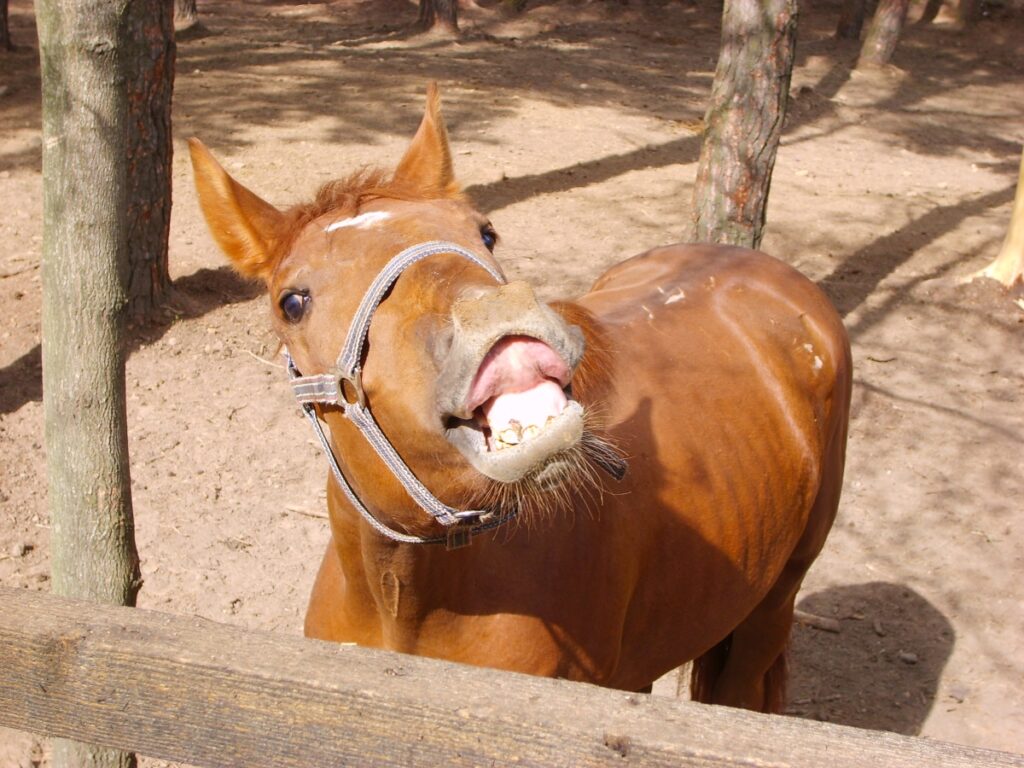
The horse rais its head and extend its neck when it curls its lip while flehmen or doing yawning motions. This behavior is sometimes noticed in colicky horses or in horses with other gastrointestinal discomfort. Flehmen can also be seen in healthy horses i.e a stallion smelling on a mare’s urine.
Sweating
During colic, the horse may sweat. In severe colic cases, sweating can be profuse.
High Pulse and Respiratory Rate
A very common sign in a horse with colic is raised heart rate and higher respiratory rate. If the horse’s heart rate is consistently high, this is a bad sign and you should call your veterinarian immediately.
Mucous Membranes Are Either Very Pale or Very Red
If blood pressure and circulation are affected, the situation is often serious. Affected blood circulation can cause the mucous membrane of the mouth to change color from its normal pale pink, becoming dark red or greyish pale, for example.

Increased Capillary Refill Time (CRT)
Impaired circulation can also mean that the smallest blood vessels, called capillaries, do not fill with blood as quickly. This can be checked by pressing a finger against the lining of the mouth for a second. When the pressure is released, the pale spot should return to its normal color in 1-2 seconds. If it takes 3-4 seconds, it is a bad sign.
Kicking
The horse may kick its abdomen or kick the wall because of abdominal pain. Always be careful when handling a horse with colic.
Lying Down and Rolling
- Lying down a lot or at unusual times.
- Lying in unusual positions (e.g. on the back)
- Rolling or throwing oneself up and down
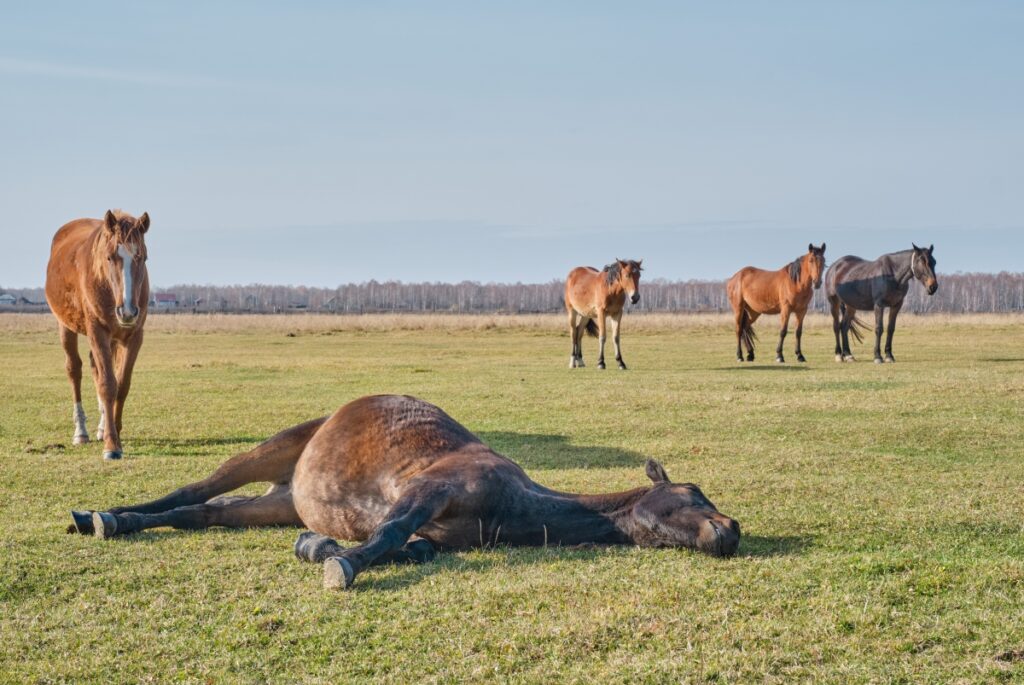
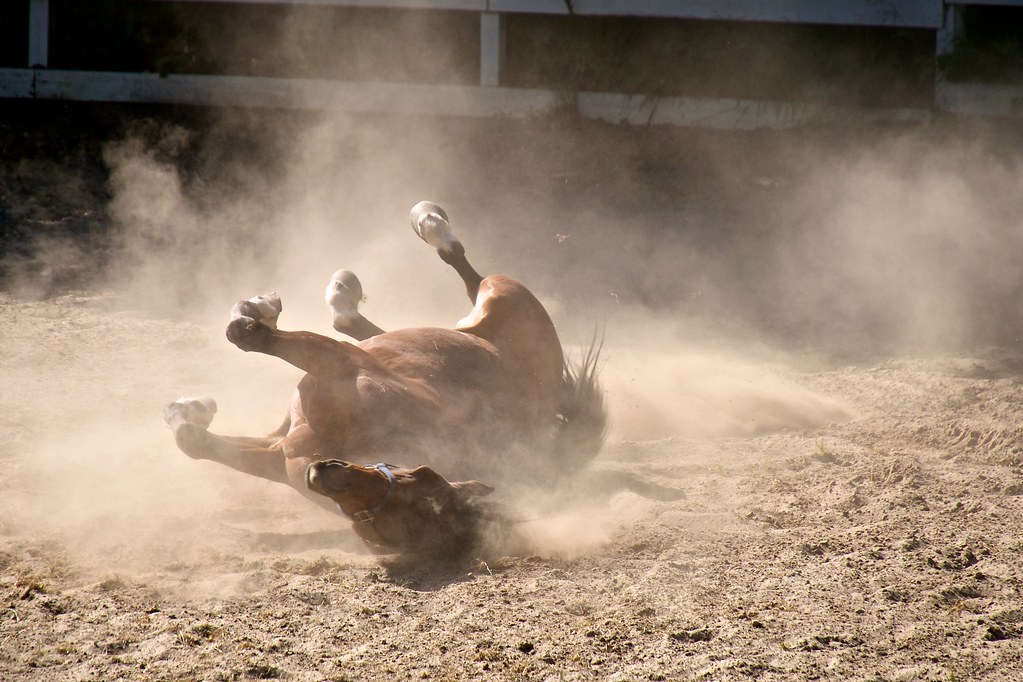
Photo: “Horse Rolling in the Dust” by donjd2 is licensed under CC BY 2.0.
Looks Like It is Trying to Urinate
Standing in a stretched position, but nothing comes. This can be confused with the horse having difficulty urinating but is usually a symptom of colic.
Have Little or No Feces Alternatively Diarrhea
The horse may defecate less or stop defecating altogether. Droppings may also have a change in consistency, become watery and runny (diarrhea), or are harder and drier.
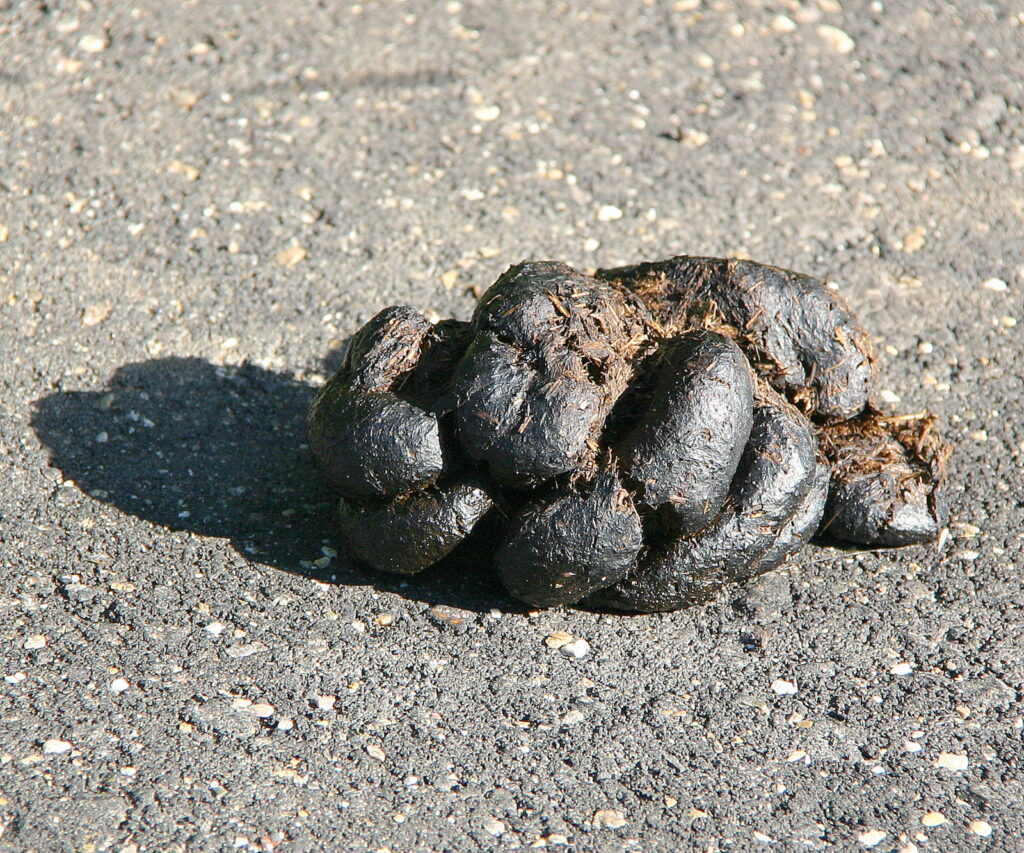
Photo: “File:Feces of horse 3.jpg” by Peter van der Sluijs is licensed under CC BY-SA 3.0.
Moaning and Grinding Teeth
Moaning and grinding teeth can be a symptom of colic or stress/pain.
Increased Abdominal Circumference (Bloating)
In some cases of gas accumulation in the horse’s intestine, you can also see on the outside that the horse’s abdomen becomes larger and balloon-shaped.
Silent or No Bowel Sounds
In colic, gut motility is changed and bowel sounds are often affected. Usually, it becomes quieter than normal as bowel movements slow down. You can hear this if you put your ear against the horse’s belly, listening on both sides. Even better, if you have a stethoscope to listen with, the gut sounds will be clearer. When the colic subsides, you can usually hear the bowel sounds coming back on.
What Should I Do When I Suspect That My Horse Has Colic?
What to do in case of colic? If colic is suspected in a horse, it is important to contact a veterinarian early do not wait until the symptoms are severe. To be able to explain correctly to the vet on the phone, it is important that the horse owner or the groom can make certain observations before the call to the vet. Check your horse’s vitals. Is there any value out of the normal range? In general, young horses up to one year of age may have slightly higher values. Individual differences may occur, learn your own horse’s normal values.
| Temperature | 98-101,5° F |
| Pulse | 28-40/min |
| Respiration | 8-16/min |
| Mocous membranes | light pink |
| CRT (Capillary Refill Time) | <2 seconds |
| Bowel sound | sound should sound more or less all the time on both sides of the abdomen |

What To Do Before Calling the Vet?
Here is a helpful list of what to do when you find your horse with colic symptoms.
Walk With the Horse
After consultation with the vet, it may be necessary to take the horse out and lead it on a walk for a while. The horse may be anxious and difficult to handle, so be careful and put on a bridle. If necessary, release the horse in the riding arena or paddock. Check for feces or flatulence.
If the horse is relatively well, it is good to have short 5-10 minutes 1-2 times an hour. Let the horse rest between walks. If it lies down and is difficult to get up, do not force the horse to walk. Call a vet immediately.

Horses often feel more comfortable moving around if they have a painful process in their abdomen. Movement of the horse can also promote movement of the digestive tract, which can help disperse a painful build-up of gas in the digestive tract.
What Does the Vet Do With a Colic Horse?
Check the Horse’s Vital Signs i.e. Physical Examination of the Horse
- Listen to the horse’s heart rate
- Check the respiratory rate
- Take temperature
- Examine the appearance of the mucous membranes and feel the elasticity of the skin.
- The actual examination of the abdominal and gastrointestinal tract begins by listening for any bowel sounds.
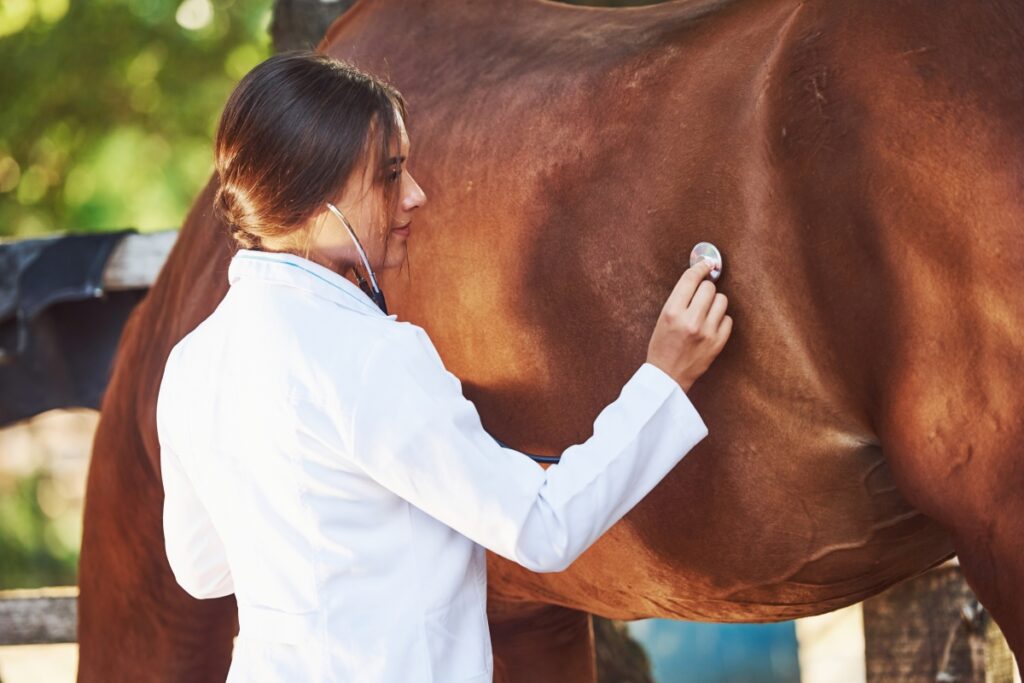
Rectal Examination
The organs of the abdominal cavity are then examined by rectal palpation, where the veterinarian inserts one arm into the horse’s rectum to examine the intestines and other organs. It is then possible, for example, to detect if there is an abnormal amount of gas in a part of the intestine, if there is constipation or if there are signs of displacement, distortions, etc. There is a risk of rectal tears under this procedure so it is important that the horse is calm and maybe sedated and/or using a nose twitch.
The cause of colic is not always found during this examination, but it is just as important to rule out as to confirm a suspicion. After all, you can only reach the rear part of the abdominal cavity.
Nasogastric Intubation (Stomach Tube)
Sometimes the examination is followed up by putting a nasogastric tube (also called a stomach tube) into the stomach. In this way, any gas that has collected there can be removed or stomach contents can be emptied. Horses cannot vomit because they have very strong cardia (the opening of the esophagus into the stomach).
Abdominal Centesis (Belly Tap)
Further investigations may be necessary, such as an abdominal puncture to see if free fluid or feed particles are present in the abdominal cavity.
Blood Tests
Sometimes blood is taken for analysis to get more information about the cause and prognosis of colic.

Diagnosis
The veterinarian will then weigh up the various findings to get an accurate diagnosis and then decide whether appropriate treatment can be carried out directly on the spot or whether the horse needs to be taken to a clinic.
Different Causes of Colic
So where do the often severe pains of a colicky horse come from? There are a variety of factors causing colic and also factors increasing the risk of colic. Sometimes the exact cause can not be found. Here are some of the most common causes of colic in mature horses:
The most common causes of colic are constipation and gas colic. Other causes can be spasmodic colic, dislocation of the small intestine or large intestine, and inflammation of the intestines or the abdominal cavity (enteritis – inflammation in the small bowel, colitis – inflammation in the large colon, and peritonitis).
Gas Colic
Cramping or gas build-up in the intestines can cause severe colic pain. In some cases, the condition may resolve spontaneously or after simple medical treatment, but it can also lead to serious conditions involving surgical intervention and hospitalization.
Constipation
Constipation can be a serious problem as it can lead to severe disturbances in fluid balance and blood circulation. Constipation can often be resolved medically (without colic surgery) by a veterinarian if you make an early diagnosis and the horse has mild colic symptoms.
Displacement Colic
The most serious causes of colic are displacement colic, volvulus (twisted gut), or intestinal disorders. Some parts of the horse’s intestines are mobile and in some conditions can become strangulated. When the intestine twists around itself, the passage of the intestine is completely blocked leading to severe pain.
The intestine can also become trapped in a hernia, in which case the intestine is also squeezed tightly and a stop is made. Older horses can develop benign tumors in the abdomen called lipomas and in these, the intestine can also get stuck and strangulated, affecting the blood flow and becoming acute. When the intestines are completely blocked, the horse suffers from circulatory problems and excessive gas accumulation. Usually, surgical treatment is required to resolve the condition or the horse must be euthanized, for example, if surgery is not possible.
The intestine can also get stuck on the splenic ligament which is located on the upper left side of the abdomen.
Small Intestinal Obstruction
A simple obstruction is usually caused by something which is simply blocking the lumen such as a feed or parasite impaction. As the horse continues to produce digestive secretions, the contents of the intestine together with these secretions will build up in the small intestine leading to a dilation. In some cases, the contents may even flow back towards the stomach and cause this to dilate as well. Therefore a simple obstruction will cause mild colic at first, which will usually become more severe as the intestine (and the stomach) becomes more dilated.
Infections Causing Colic Signs
Infections such as salmonella, equine coronavirus, and rotavirus can cause colic, often with fever, and diarrhea is common.
Gastric Ulcers: Low-grade Colic
Gastric ulcers can cause a more low-grade and chronic form of colic.
Different Treatment Options for Horse Colic
Pain Management
Treatment varies depending on the cause of the colic. Pain relief is usually the first step in the treatment of colic. In the case of cramp or gas colic, an anticonvulsant and analgesic injection may be sufficient.
Never give pain medication (e.g. flunixin meglumine / Banamine) to a colic horse without consulting a vet. Drugs can mask the symptoms and make it take longer for the horse to come under proper care.
Hydration and Laxation
In the case of constipation, it may be necessary to add lubricating mineral oil through a nasogastric tube, also with water through the tube. It is important to restore fluid balance as colicky horses are often dehydrated. This can be done by giving the horse a drip.

Photo: “Horsey Hospital” by R~P~M is licensed under CC BY-NC-ND 2.0.
Hospitalization and Colic Surgery
In more severe cases, the patient may need to be admitted to the clinic to receive fluids and shock treatment by drip. In cases of bowel displacement, dislocation, and some types of constipation, emergency surgery may be required. Colic surgery is performed under general anesthesia and it is of great importance to make the right diagnosis early on to get the best possible conditions. The good news is there has been rapid progress in surgical colic and many cases of colic that only a few years ago usually led to death are now being successfully operated on. However, an important factor is time. The sooner the horse comes under treatment, the greater the chance of a successful outcome. The longer you wait, the more serious the complications in the gastrointestinal tract, blood circulation, and fluid balance!
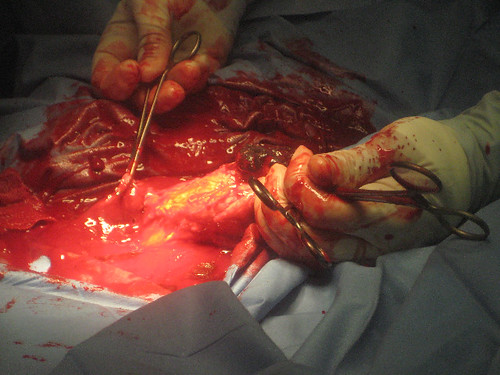
Photo: “Schirrous Cord, Complication of a Routine Castration Procedure 2” by Vet Moves.com is licensed under CC BY 2.0.
Feed Management
Since colic symptoms originate from the gastrointestinal tract, it is natural to look for the cause in the feed or feeding practices. Is there anything that needs to be changed?
Intestinal bacteria (“gut flora”) are important components in the horse’s breakdown of the feed. At the same time, they are sensitive to changes in feeding or feeding too much grain or concentrate, which is why the transition from one feedlot to another or from one forage to another is always done gradually. Sudden and rapid changes in feed, as well as poor quality feed, can lead to disturbances in the intestinal flora, which in turn can lead to gas colic or constipation. The same applies to irregular and long feeding intervals.

A horse that has been feeding on concentrates (perhaps loose in the stable?) can also be a cause of intestinal flora disturbances resulting in abdominal pain. Irregular exercise, long hauls, extra hard work, and other stresses can also contribute to gastrointestinal dysfunction with feed digestion problems and colic symptoms.
Avoid Sandy Pastern
Horses on pasture in sandy areas can suffer from a particular type of colic called sand colic, which is caused by the prolonged ingestion of sand. The sand then accumulates in the gut and causes colic symptoms. Sandy soil can give severe problems with colic and special attention needs to be taken to prevent horses from getting sick:
- Do not give feed on sandy ground
- Give psyllium to prevent sand buildup
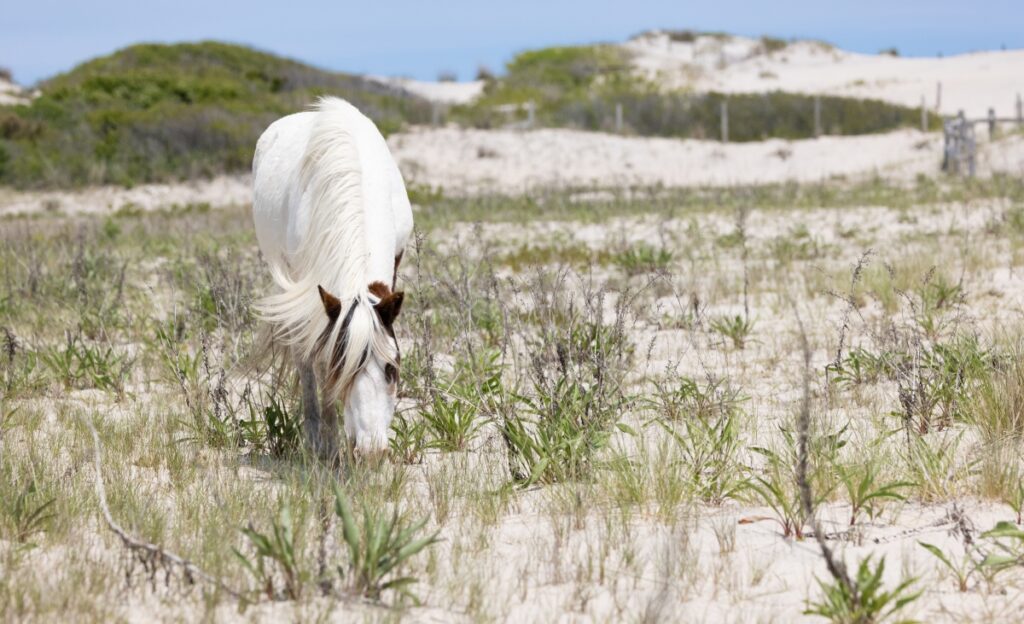
Provide Fresh Water
During the cold season, horses that have access to roughage in the pasture must be also offered plenty of water. Otherwise, horses may suffer from colic. A temperate tub of water or a water bowl with frost-free water in the pasture allows the horse to drink when it wants and needs to.
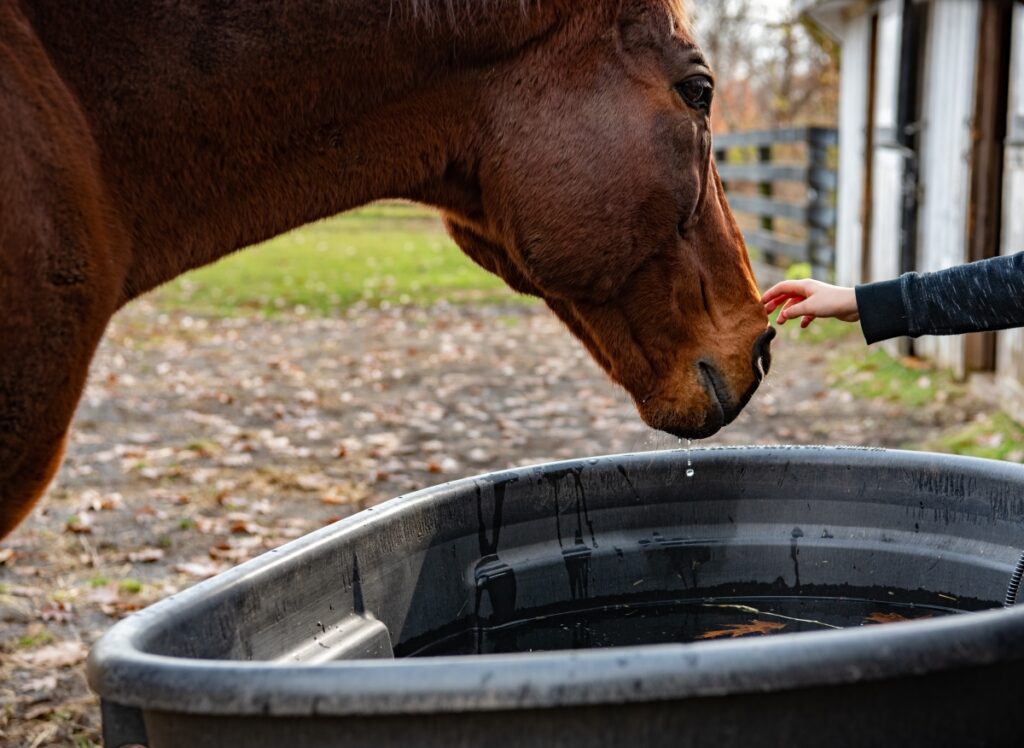
Parasites Can Contribute to Colic
Parasite infestations can cause damage that leads to colic. In foals and young horses, copious amounts of roundworms can cause colic symptoms and in older animals tapeworms can cause changes in the transition from the small intestine to the appendix.
However, the most important parasitic cause of colic in horses is the damage to the blood vessels of the intestines caused by the larvae of the large bloodworm (Strongylus Vulgaris). During their development, they migrate up the blood vessels leading from the aorta (the main artery of the body) to the intestine. This causes damage to the walls of the blood vessels, disrupting the blood supply to the intestine. Depending on the extent of the damage caused by the larvae, the result can range from mild recurrent colic attacks to severe and life-threatening disruption of the intestinal blood supply. Such cases can be avoided with good management and deworming at the correct time, do not use home remedies.

Photo: “File:Strongylus vulgaris.jpg” by Froggerlaura at English Wikipedia is licensed under CC BY-SA 3.0.
What Can I Do To Prevent my Horse From Getting Colic?
The horse is a migratory, grass-eating herd animal with a complex digestive system. It is a prey animal that has evolved for life on the steppe and grazing 14-18 hours a day. To prevent colic and other diseases we should keep this in mind and eliminate risk factors and sometimes do management changes to lower the colic risk.
- To reduce the risk of gastrointestinal disorders, the horse must be exercised regularly.
- Energy should come as much as possible from roughage or grass, divided into several meals a day. There are hay nets with small holes in them to extend the eating time of horses that do not get much roughage or that eat very quickly. Don’t make any abrupt changes with forage as these sudden changes can cause different types of colic.
- The horse should have access to fresh and clean water at all times and this is particularly important when feeding. Remember that water gets cold and freezes quickly in winter. Most horses drink too little when the water is too cold. This is one of the most common causes of constipation.
- Well-managed pasture with no noxious weeds or foreign objects.
- Regular examination of the horse’s oral cavity and teeth is important! If the horse cannot chew its food properly or drink enough because of irritation in the teeth, this can cause digestive problems and there is a risk of colic.
- Gastrointestinal parasites can in some cases cause colic in horses. To know if and with which medical management the horse should be treated, a fecal sample can be taken and submitted for analysis.

Conclusion & Disclamer
Colic can be a serious condition and you should always be aware of your horse’s symptoms. If you notice colic symptoms, you should always consult your local vet immediately as colic should be treated early to reduce the risk of more serious outcomes.
If your horse is sick, or you suspect it might be sick, always contact your local veterinarian immediately. This article is not a substitute for your local vet, it is a helpful tool to learn more about horses. Your local veterinarian can decide whether your horse needs to be examined or treated.
Sources
Gleerup KB, Forkman B, Lindegaard C, Andersen PH. An equine pain face. Vet Anaesth Analg. 2015 Jan;42(1):103-14. doi: 10.1111/vaa.12212. Epub 2014 Jul 31. PMID: 25082060; PMCID: PMC4312484.
James A. Orsini, Thomas J. Divers, Equine Emergencies (Fourth Edition), W.B. Saunders, 2014, ISBN 9781455708925
Stephen M. Reed, Warwick M. Bayly, Debra C. Sellon, Equine Internal Medicine (Second Edition), W.B. Saunders, 2004, ISBN 9780721697772,

